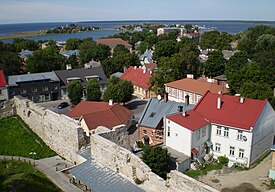Haapsalu, Estonia
| Haapsalu | |||
|---|---|---|---|
| Town and municipality | |||

View from Haapsalu Castle
|
|||
|
|||
| Location in Estonia | |||
| Coordinates: 58°56′22″N 23°32′27″E / 58.93944°N 23.54083°ECoordinates: 58°56′22″N 23°32′27″E / 58.93944°N 23.54083°E | |||
| Country |
|
||
| County |
|
||
| Town rights | 1279 | ||
| Government | |||
| • Mayor | Urmas Sukles (Reform Party) | ||
| Area | |||
| • Total | 10.59 km2 (4.09 sq mi) | ||
| Elevation | 10 m (30 ft) | ||
| Population (2016) | |||
| • Total | 10 146 | ||
| Ethnicity | |||
| • Estonians | 81% | ||
| • other (Finns, Swedes, Russians) | 19% | ||
| Time zone | EET (UTC+2) | ||
| • Summer (DST) | EEST (UTC+3) | ||
| Postal code | 90503 to 90507 | ||
| Area code(s) | (+372) 047 | ||
| Vehicle registration | S | ||
| Website | www.haapsalu.ee | ||
Haapsalu (Estonian pronunciation: [ˈhɑːpˈsɑlu]) (swedish: Hapsal) is a seaside resort town located on the west coast of Estonia. It is the administrative centre of Lääne County, and on 1 January 2016 it had a population of 10 146.
Haapsalu has been well known for centuries for its warm seawater, curative mud and peaceful atmosphere. Salt mud spas frequented by the Russian Romanov family still operate. Narrow streets with early 20th century wooden houses repeatedly lead to the sea. Haapsalu has been called the "Venice of the Baltics", although this positioning has been criticized as exaggerating. The name "Haapsalu" is from Estonian haab 'aspen' and salu 'grove.'
The town dates back to 1279, when it was chartered and became the centre of the Bishopric of Ösel-Wiek, which it remained for the next 300 years. Buildings from those early days remain today, including an episcopal castle which has the largest single-nave cathedral in the Baltic states, Haapsalu Castle.
Haapsalu and the surrounding area was the center for the Estonian Swedes from the 13th century until the evacuation of almost all ethnic Swedes from Estonia in 1944.
For many years, locals have claimed that the sea mud has a curative effect. A military doctor, Carl Abraham Hunnius, founded the first mud cure resort in 1825. News of the curative mud quickly reached the aristocracy of Saint Petersburg, the capital of the Russian Empire. Ever since then, Haapsalu has been a popular summer destination where people from all around the world come for medical treatment. Today, there are three mud cure establishments in Haapsalu varying in size and location.
...
Wikipedia



